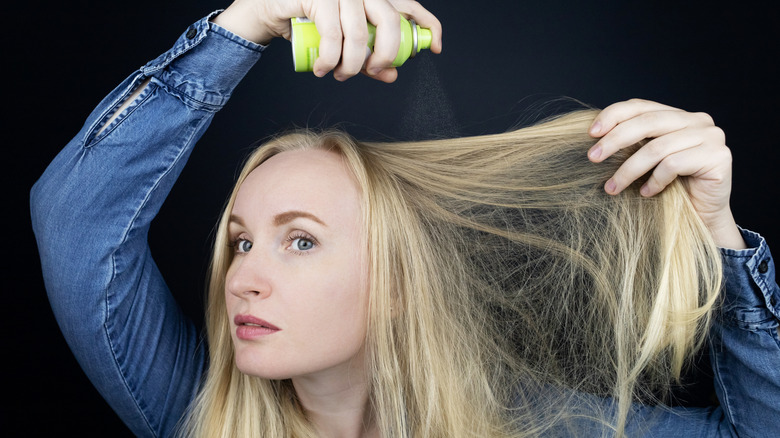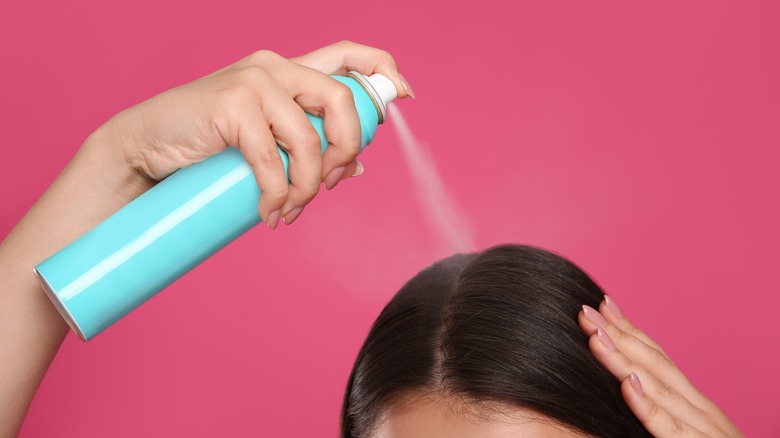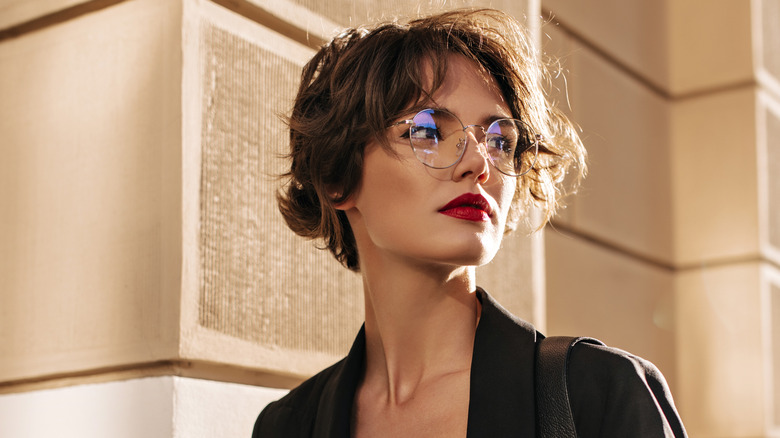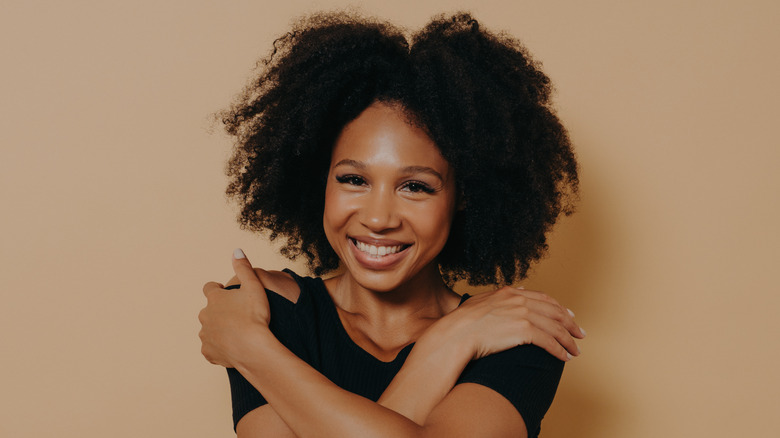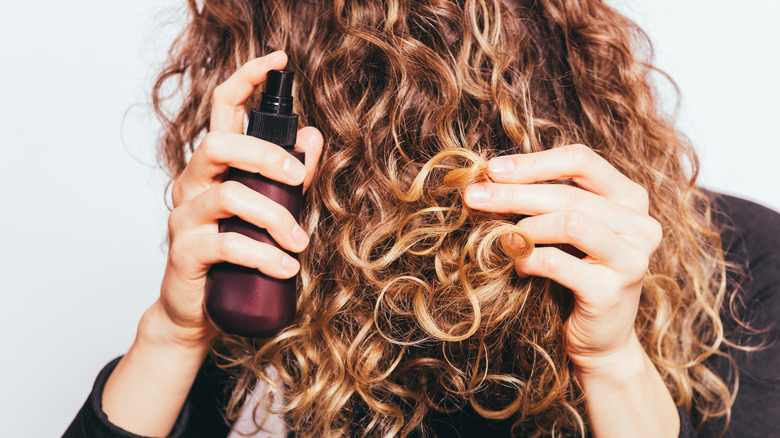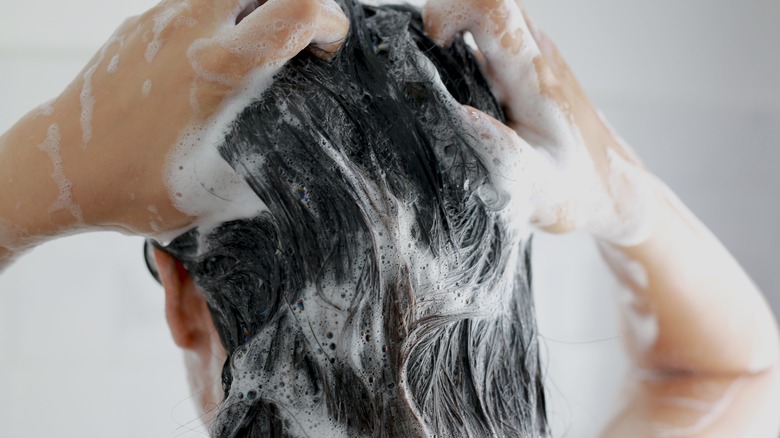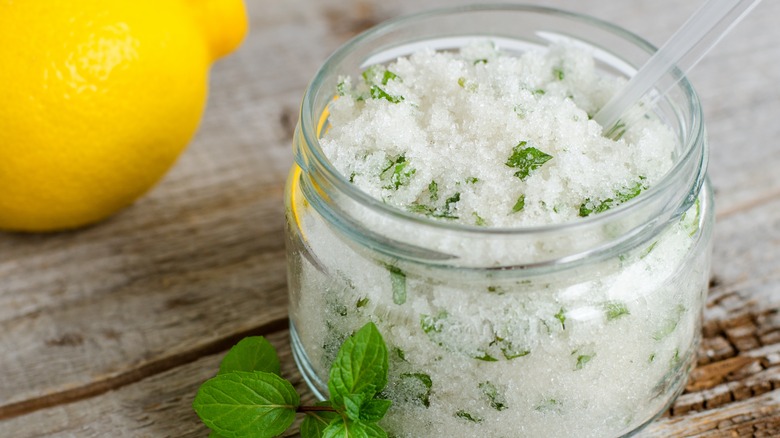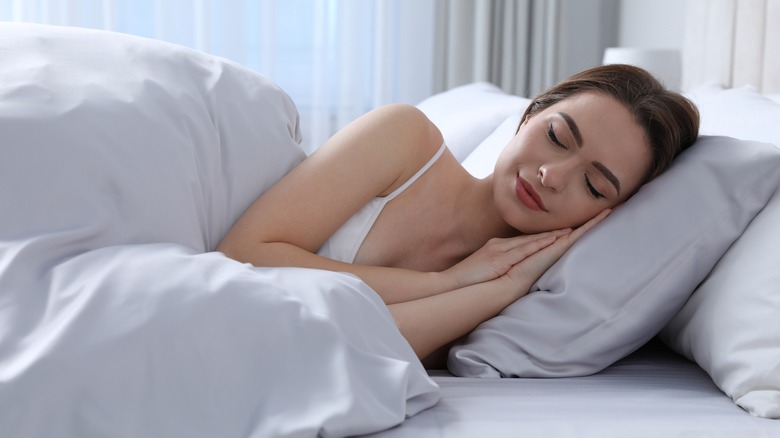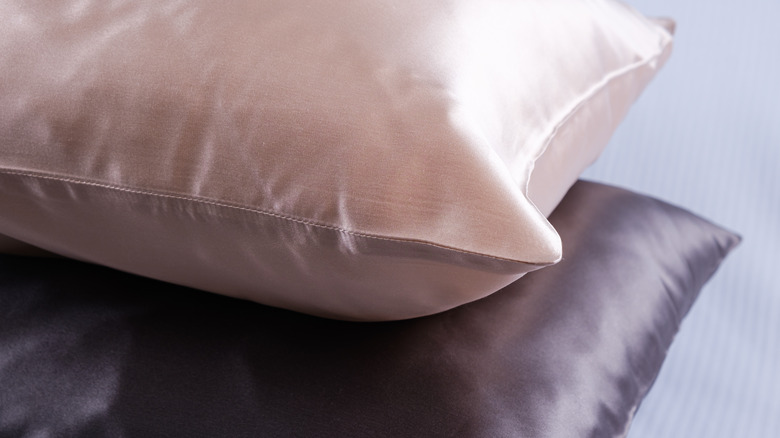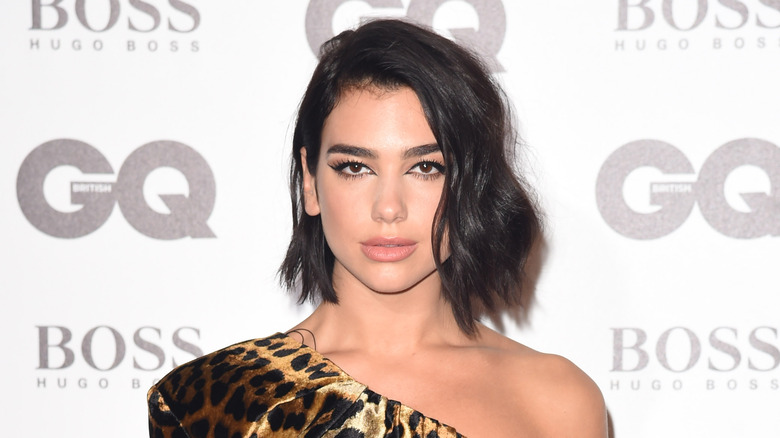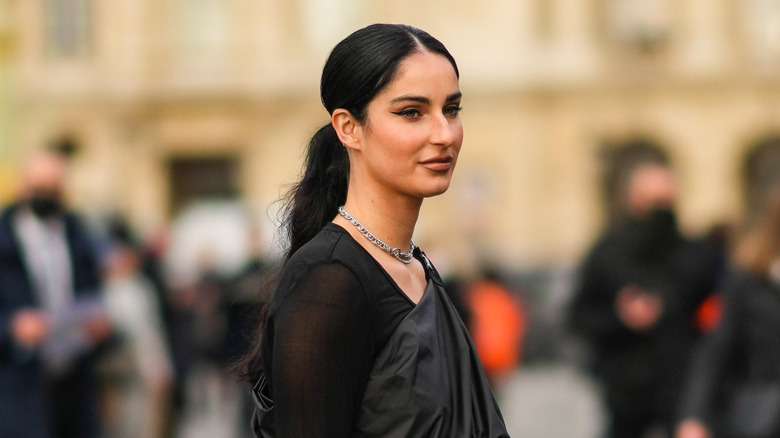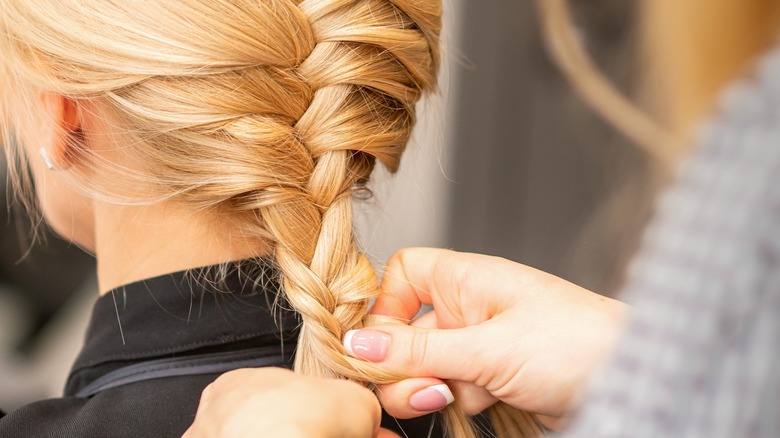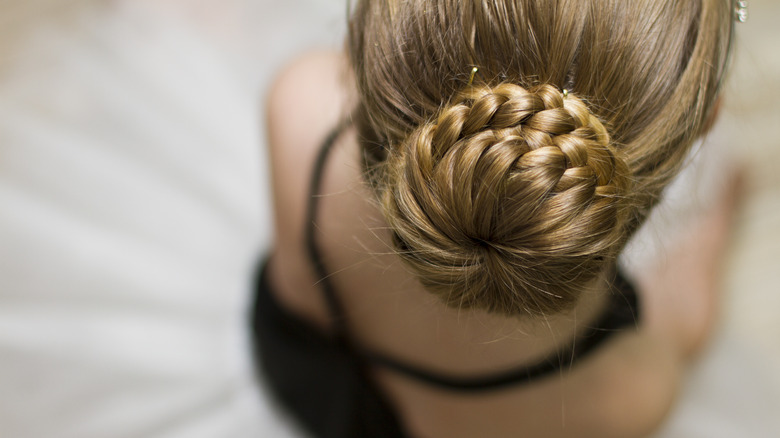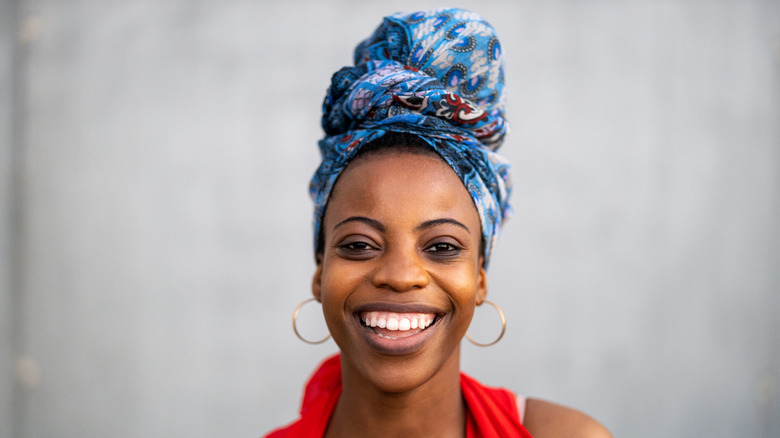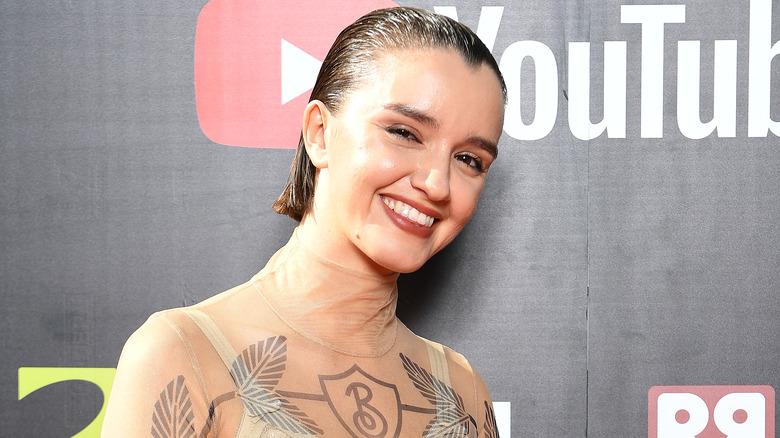Genius Ways To Manage Second-Day Hair
For most of us, the first day we wash and style our hair is when it's at its shiniest, bounciest, and most voluminous. But for many of us, washing our hair daily isn't a realistic part of our routine — and it's also not good for the hair in general. According to Marie Claire, washing your hair every day can lead to the removal of the hair's natural oils, which leads to dryness and brittleness. Yikes. Enough said!
Although washing hair daily is unhealthy, that doesn't mean you just have to deal with greasy, frizzy hair on the days you don't wash. With a bit of inventiveness (and a few helpful products), your second-day hair can look just as good as it did on the first day.
So, how do you keep hair looking soft and healthy in the days after washing? Below, we've compiled fourteen genius ways to manage second-day hair.
Dry shampoo: It's a go-to for a reason
Depending on your hair and scalp, there's a chance that second-day hair means greasy roots. But have no fear: a good dry shampoo can absorb any oil you're dealing with and can add texture and volume. Simply apply the dry shampoo to the roots of your hair, rub it in (nothing worse than roots with the telltale dry shampoo white cast!), and your hair is instantly refreshed.
If you're not sure exactly which dry shampoo will work best for you since there are a lot of aerosol and powder versions on the market, consider your hair type and your lifestyle. A dry shampoo powder can be a bit messier and time-consuming, while an aerosol spray can work quickly and on the go. Hairstylist Briella Calafiore said (via Reader's Digest) that powder dry shampoos can be "a good idea for extra oily hair," while aerosols "cover a lot of ground in a quick amount of time" and "help fluff up your hair."
While it is undeniable dry shampoo is the ultimate pick-me-up for second-day hair, it's important not to overdo it. Calafiore explains, "A healthy scalp needs time to breathe, and too much dry shampoo can clog the follicles. So use dry shampoo in moderation in between using the best shampoo for your hair type."
Texture spray
Ever had an amazing hair day one day, just for your hair to turn into a flat, limp mess the next day? It's an unfortunate but common situation, but one thing that can help it is texture spray. According to hairstylist Polko (via Byrdie), texture spray is "great at reviving two- or three-day hair without adding too much oil."
Especially for those of us with fine hair, texture spray can add some much-needed body and volume, and it also gives the hair some grip, making it a useful product to use before putting hair in a braid or ponytail. One thing to keep in mind? Moderation is key. "The most common mistake people make is spraying it too close and using too much," hairstylist Chad Wood explained (via Hair). "You should really spray an arm's length away, and you want to spray and mist and shuffle, brush out your hair, pull it out as you're misting. Do it ever so slightly and build it."
Volumizing mousse
Want to ensure that your hair looks good on the day you wash it and the next day? Consider prepping your locks with a volumizing mousse. On damp hair, apply mousse to the roots and evenly distribute through the hair. What exactly does the mousse do? According to hairstylist Aaron Grenia (via Byrdie), it provides "hold, style memory, lift, and bounce." Basically, it ensures that your hair will stay looking good, even into the second day.
If you haven't used mousse before, you may be worried that it will make your hair crunchy. However, this is pretty easy to avoid as long as you don't use too much product; if you have fine hair, start with a small amount. Overall, Grenia calls mousse one of his "favorite products" and says there's no reason not to try it out. "People should not be frightened of mousse," he said. "Out of all of the products out there, mousse is the easiest product to use and the most versatile."
Moisturizing mist
Some of us may be lucky enough not to deal with greasy second-day hair ... but instead, we get loads of frizz. Especially for those of us with natural or curly hair types, maintaining softness and smoothness can be difficult post-wash.
One solution for taming second-day frizz is a moisturizing spray or leave-in conditioner. According to L'Oreal, you can simply spray curls with water, then follow up with a leave-in conditioner spray. Per L'Oreal, using water and leave-in conditioner can help you have an easier time styling hair: "Since it's a bad idea to try and manipulate curls without any moisture, this method helps to soften and shape your mane sans the fear of frizzy hair."
Additionally, using a leave-in conditioner means your hair is softer and easier to detangle, ultimately protecting it from damage and breakage. Just remember: The finer your hair is, the less product you need to use.
Use special shampoo
To give yourself flawless second-day hair without even touching the dry shampoo bottle, it's important to prepare your hair in the shower. Sometimes good hair is a long game, and the one of the most important things you can do is wash your hair with a clarifying shampoo. Thanks to clarifying shampoos' deep cleaning abilities, your hair will stay bouncy and soft even when that second day rolls around.
Hairstylist Lauren Grummel also recommends finding shampoos and conditioners that are paraben- and sulfate-free. "Finding the right shampoo and conditioner makes all the difference," she said (via Glamour). Grummel recommends ingredients like thyme, rosemary, and tea tree oil if you're someone who gets greasy second-day hair. Witch hazel can also be a good shampoo ingredient to look for, according to Grummel: "Witch Hazel is [another] known natural antiseptic that helps detoxify the hair and scalp. It also tightens the cuticle, adds radiance, and restores balance so that hair looks and feels soothed and softened."
Invest in a scalp scrub
Just how using a special shampoo can lead to better hair, so can a good scalp scrub. If you're new to scalp scrubs, they come in a few different forms: store-bought scrubs, scrubbing devices (often small brushes that allow you to manually scrub the scalp), and DIY scrubs. According to Byrdie, sea salt mixed with an essential oil, such as peppermint oil, is a go-to DIY scalp scrub recipe.
A scalp scrub can be especially beneficial for creating great second-day hair because it ensures that the scalp is fully cleansed, removing any product buildup and thereby preventing the oiliness that can sometimes happen the day after washing. Dermatologist Debra Jaliman said (via Byrdie), "Scalp exfoliation makes way for fresh skin and hair follicles to grow healthy hair. Many people pay more attention to their hair rather than their scalp, but the truth is that a healthy scalp will produce healthy hair."
Just like a good shampoo can go a long way for priming the hair to stay soft and clean for several days, a scalp scrub can ensure that your second-day hair is healthy and oil-free.
Keep hair maintained at night
If you tend to go to bed with your hair strewn all across the pillow, you're definitely not alone. But adopting a nighttime hair routine can be key to good second-day hair. Here's why: When you go to bed without thinking about your hair, it will likely get tangled and messy, meaning you have to touch it and style it more the next day to make it look good. And if you didn't know, touching your hair too much can lead to super oily strands: According to Southern Living, every time you touch your hair, the oils that naturally occur on your hands are transferred right into your hair.
So how can you avoid the oil slick and minimize the amount of styling your hair needs on the second day? Consider protecting your hair at night, either by putting it in a style that will keep hair neat and smooth, like a braid, or try putting your hair into a scarf or wrap it overnight. Not only does this minimize the amount of styling you'll have to do when you wake up in the morning, but it also keeps hair smooth and soft, according to L'Oreal.
Invest in a silk pillowcase
One of the best things you can do for your hair is investing in a silk pillowcase. Board-certified plastic surgeon Jaimie DeRosa said (via Byrdie) that silk pillowcases "can prevent knotted and frizzy hair, which can be a problem, especially for those with long hair. The tightly woven structure of a 100% silk pillowcase decreases friction between the hair and the material, resulting in less frizzy and tangled morning hair." Less frizzy and tangled hair = better second-day hair.
A silk pillowcase doesn't just make your hair look good — it can actually keep hair healthier, according to DeRosa, "Silk is so tightly woven that it allows hair to move smoothly about its surface without getting caught in between the strings of fabric. This results in less hair breakage and may also reduce the number of split ends."
And if you need more reasons to invest in a silk pillowcase, it's a more hygienic option than other pillowcase materials. "Silk is hypoallergenic and does not contain chemicals," DeRosa said. "... It will not retain dust, fungi, [and] bed mites, as well as pollen and mold."
Try a different parting
Gen Zs may disagree, but sometimes a side part is a good look — especially if you're trying to amp up second-day hair. If you typically part your hair in the middle, switching to a side part for second-day hair can give you a boost in volume that you wouldn't get by keeping the same part. And, of course, if you tend to opt for a side part, trying a middle part or switching sides can offer the same amped-up volume.
Hairstylist Lacy Redway is a fan of a deep side part, slicked back on one side with crisscrossed bobby pins. Redway told Allure that the edgy look is especially good for people with shorter hair or bobs or for those who are growing out their hair. After creating a deep side part, Redway suggests blow-drying hair with a round brush to create a sleek finish. Then, get some bobby pins and secure the hair just under the ear with the pins pointing "in various directions."
Sleek ponytail
There's really nothing more classic than a sleek ponytail, and it just so happens to be the ideal hairstyle for second-day hair. If you're someone who tends to get oily roots on the second day, this isn't necessarily a bad thing — the greasiness can help you achieve a slicked-back, sleek look. According to hairstylist Justine Marjan (via Allure), "You can use the natural oils to your advantage."
To achieve a chic, second-day ponytail, you should, according to Marjan, "use a smoothing brush to gather hair into a low ponytail." If you find that your hair is being unruly, Marjan recommends using a "small amount of gel" to help smooth the hair back. And while your natural oils can help to keep the hair slicked back, don't be afraid to use a little dry shampoo if things are looking a little too oily. To take the whole look up a notch, consider adding a fun hair accessory, like a ribbon or statement headband.
Loose braid
If your second-day hair is not cooperating, there's one style that you always fall back on: a loose, boho-inspired braid. Not only will it look effortlessly cool, but it requires very little styling. Putting your hair in a braid also keeps it cleaner since you're less likely to be touching it. "Dirt from your hands can accumulate in the hair whenever you touch it. Putting your hair in a loose bun or braid will keep it away from an oily face or sweaty neck," according to hairstylist Dominic Roach (via Glamour).
If you have short or layered hair that doesn't stay in a braid very well, don't worry. You can experiment with alternatives to the classic braid, such as braided bangs (via Byrdie). To get your bangs swept off your face and into two braids at the crown of the head, hairstylist Niani B. said, per Byrdie, to part the hair in the center, then section off two front chunks of hair on either side of the part. Then, "Create one flat twist on each section, leaving the ends loose, and secure the twist with an elastic band, hair pin, or hair clip," Niani recommended.
Chic braided bun
If you want your second-day hair to look chic and sophisticated, consider opting for a braided bun. Combining the classic feel of a braid with the elegant look of a bun, this hairstyle can also disguise any grease or frizziness you may be dealing with post-wash.
According to hairstylist Kristin Ess (via Allure), the braided bun is a "polished-looking solution to stringy strands." If you want to try this look yourself, Ess recommends first using a texturizing spray to give the hair some grip and a matte texture. Then, Ess says to bring the hair into a low ponytail and use hairspray if necessary to tame flyaways. After that, you'll want to "Braid the length of your hair starting at the nape of the neck and wind [it] clockwise into a bun, tucking the bottom of the braid into the center of the bun." Despite how pretty and elegant the finished hairstyle looks, it's really as simple as braiding your hair, then twisting it into a bun.
Head wrap or scarf
If your second-day hair is too greasy, tangled, or frizzy to even deal with, you don't have to throw in the towel altogether. Instead, you can try a head wrap or scarf. Head wraps are already staples for many people with natural hair, but they can be a fun look for people with any hair type. According to hairstylist Whitney Eaddy (via Marie Claire), "Traditionally, head wraps have served functional purposes like protecting women's scalps from the sun, sweat, and grime."
However, head scarves can also be a great way to cover up unruly second-day hair. You can find a fun, patterned one, or go for a sleek silk option—whatever suits your mood and style. "Head wraps and scarves are extremely versatile," Eaddy said. "There are endless ways to wrap and tie a head wrap, and many examples and tutorials can easily be found online."
Don't fight the oil
When it comes down to it, all of us get greasy hair sometimes, and it's really nothing to be ashamed of. So instead of piling on the dry shampoo or scrambling to hide oily roots, you could go full-throttle and embrace them. "Don't fight your hair's natural oil," hairstylist Laura Polko recommends (via Glamour), adding that "Greasy hair is the best for a slicked back look."
The slicked-back look has been a trendy hairstyle for a while now, and according to Vogue, it's still an on-trend option for 2023. According to hairstylist George Northwood, "Ultra glossy, impossibly shiny, wet-look hair is a 2023 trend that is set to be everywhere."
To get your second-day hair sleek and slicked back, you can work with your natural oils by brushing the hair back and spraying with hairspray to keep it in place. To get the wet look that Northwood mentions in Vogue, combing a gel through dry hair can help to achieve the trendy look.
